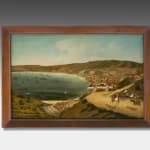View of Valparaíso, Chile
circa 1840
59.75 x 91.5 cm
Further images
Provenance
This painting came from the collection of Captain Hall Jackson Tibbits (1797-1872). The Captain owned several clipper ships, trading tea and silk on a trade route between America, China and South America. Trade with the Far Eastern Empire was lucrative between 1830-1860, as Chinese furniture, silk and tea was in high demand in the West, but it was a tough market and engaging in the China Trade was not for the faint-hearted. In 1852, at the age of 55, the Captain bought a 127-acre farm on Sands Point, Long Island. Captain Tibbits brought his extensive collection of curios and paintings from his trips to China. He died in 1872 and his son, George came from San Francisco to be with his mother. The house remained in the family until spring 1959 when it was sold. Before this sale, all of Tibbits’ China Trade memorabilia were moved to a descendant’s home in Wadding River, New York, where it remained for over 50 years.Depicting the view of the harbour and city of Valparaíso with American and European ships anchored in the bay. This view was likely done in Canton from an existing print of Valparaiso. Likely created in Canton from an existing print.
Valparaíso: Valparaíso is a city, port, and commune of Chile, centre of its third largest conurbation (Greater Valparaíso). It is located 69.5 miles (111.8 km) northwest of Santiago and is one of the country’s most important seaports. The city is the capital of the Valparaíso Province and the Valparaíso Region. Valparaíso played a very important geopolitical role in the second half of the 19th century, when the city served as a major stopover for ships traveling between the Atlantic and Pacific oceans by crossing the Straits of Magellan. Always a magnet for European immigrants, Valparaíso mushroomed during its golden age, when the city was known by international sailors as “Little San Francisco” and “The Jewel of the Pacific.”
A similar composition print in a steel engraving entitled Valparaiso, published in a volume of L’Univers. Histoire et description de tous les peuples (Paris, 1840). The chapter on Chili is by M. César Famin.














